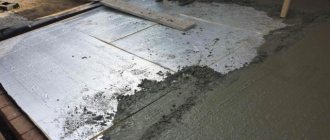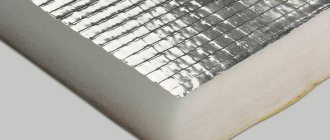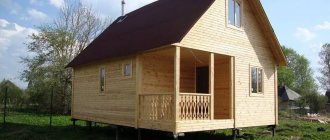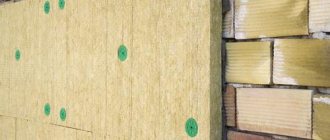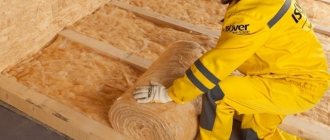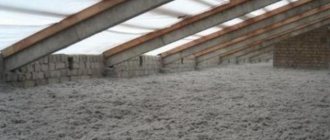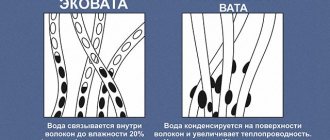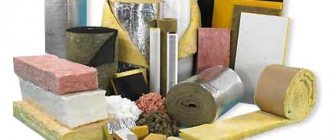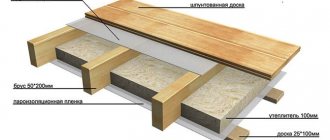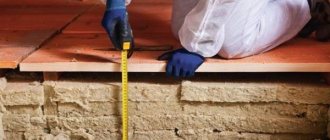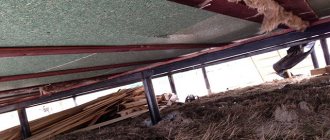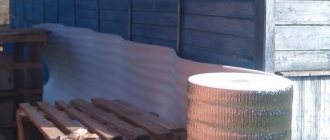Beton-House.com
Website about concrete: construction, characteristics, design. We combine the experience of professionals and private craftsmen in one place
Insulation of concrete floors with thermal insulation boards
Concrete allows you to create strong, durable foundations that can withstand significant loads, which is why this material is most often used for flooring in private homes. With all its positive qualities, a concrete floor has the ability to release heat from the room, and since its area is rather large, the heat loss is very noticeable.
Therefore, one of the measures for installing a concrete floor is its insulation. This article will tell you how to insulate a concrete floor in a private house.
- Insulation in the screed
Technologies and methods
In general, there are two ways to get a warm concrete floor. The first is to warm it up. The second is to take care of insulation, but in this case the floor will not be warm. With the right solution, it will not be cold, and this is a significant difference. We will not consider the installation of heated floors, since these are special technologies. Now there will be a list of ways to get a non-cold concrete floor.
- Insulated screed. Insulation (EPS) is placed on the concrete base, and a reinforced screed is poured on top. Sometimes pipes are rolled into it to create a warm concrete floor from heating.
- Logs are laid on a concrete base. The distance between them is filled with mineral or basalt wool. A base for laying the finishing coating is nailed on top of the joists.
You can insulate a concrete floor in a private house or apartment in various ways. - Dry screed using Knauf technology. This is a backfill with expanded clay sand, on top of which a gypsum fiber sheet (gypsum fiber sheet) with a thickness of at least 20 mm is laid. The result is a floating floor.
- Use “traditional” floating floor technology. Lay insulation (EPS) on the concrete slab, plywood or the same gypsum fiber board in two layers.
These are the main ways to insulate a concrete floor in a private house or apartment. The first option is where the screed is poured over the insulation layer; it is the “coldest” of all. At the same temperature, concrete will feel much colder than all other coatings. All other methods use sheet materials as a base for the finishing floor covering. Even without heating, they feel “warm” because they have low thermal conductivity. That is, they do not take away the heat of your body, due to which they feel warmer.
How to insulate a floor in a country house without dismantling the old floor, step by step from above
The beam structure of the base is considered more reliable and optimal. The strip foundation also allows for the installation of thermal insulation along the joists. Warming takes place in stages:
- Installation begins with laying the skull blocks or boards. They are attached to the floor beams. A subfloor made of plywood sheets or second-grade boards is mounted on these supports. To use less building material and provide ventilation for thermal insulation, the boards are attached with a gap. A waterproofing layer is attached to the rough coating, which simultaneously protects against drafts and acts as a vapor barrier.
- Then the heat-insulating material is attached in 1-2 layers. With double flooring, the insulation is placed so that the joints of the first layer are covered with the second layer. To protect against vapor formation, a vapor barrier layer is laid on top of the thermal insulation.
- A slatted counter-lattice is mounted to the joists. It presses the vapor barrier and provides a technological gap (2-3 cm). Sometimes, to protect against rodents, reinforced fine mesh is placed under the waterproofing layer on the subfloor.
On a note!
If the rough base is laid without lyes, penoplex acts as thermal insulation. The underlay of the waterproofing layer can be dispensed with.
Insulated screed: device and main points
As has already been said, even concrete cut off from the cold of the ground will not feel warm under your feet. Only if there is a heated room below. In this case, the concrete slab heats up to the air temperature in the room, but it is still not +27°C.
Insulated concrete floor for concrete preparation
How to insulate a concrete floor in a private house? For laying in the screed, it is better to use high-density polystyrene foam. Not less than 35 kg/m³. Even better is extruded polystyrene foam (EPS). With a smaller thickness, it has higher thermal insulation properties. The second plus is that it practically does not absorb water. That is, it will improve waterproofing itself.
Device nuances
A few points about the materials that should be used for such insulation of a concrete floor.
- Bottom concrete slab - this can be a cement-sand mixture or concrete with gravel. Expanded clay is not used as a filler here. The thickness of the concrete preparation is from 5 cm, the solution can be M100. It's not worth it any higher. M75 is also possible.
- The waterproofing is dense and reliable. It cuts off moisture in the soil. It is factory installed on walls no lower than the finished floor level.
- Insulation. For concrete screed, it is better to use EPS, and high density. The thickness depends on the region, but the minimum is 5 cm. Optimal is 10 cm, in two layers of 5 cm each with seams spaced apart. If you are going to insulate a concrete floor in a private house, then 3 cm of insulation is laid along the outer walls. The height is higher than the insulation of the base or higher than the level of the finished floor.
- Reinforcement - welded mesh with a pitch of 100*100, made of wire of at least 3 mm in diameter. Grid cards are stacked with overlap of at least 15 cm on top of each other. Under a warm floor, the cards are tied in places where there are overlaps; a floor without heating does not require tying.
Pouring screed over insulation on a slab - Concrete screed. With a thickness of 5 cm or more, it can be made of concrete with fine gravel filler (grain size no more than 1/2 of the slab thickness). To reduce the number and size of cracks, it is better to add fiberglass. The strength of the upper concrete slab is from M150 and above.
The solution itself is an insulated slab, a good one. Especially if you make floors on the ground in a private house. It allows you to reduce heating costs, but without heating the floor will not feel warm. If the chosen finishing coating does not provide for a substrate, it is worth laying sheet material on the concrete - any material you see fit. And if the technology for laying the finishing coating requires a substrate, then it is better to choose it with minimal thermal conductivity and sufficient thickness. This, again, will reduce heating costs and also provide that “warm” floor under your feet.
Choice
Concrete screed is far from the only way to insulate and level floors, especially in a private home. Instead, wooden logs are often used, which are easier to install, do not require long exposure, allow you to create a mini-underfloor (technical space for laying communications and storage), and, importantly, are lightweight.
Mineral wool
Spray polyurethane foam
Almost any insulation is suitable for such structures - from traditional mineral wool to ultra-modern sprayed polyurethane foam. Since the space between the joists is filled with a heat insulator, and the top is covered with OSB or plywood, it does not bear any load. The method of laying all components of the floor is dry. Consequently, neither high strength nor moisture resistance is required from the insulating material. And the consumer has much wider choice.
Expanded polystyrene
Expanded clay
Only two options are recommended for concrete screed: expanded polystyrene and expanded clay. Both work well in bending and compression, and have not only heat but also sound insulating properties. The materials are absolutely safe for health and are not affected by fungus. To make a specific choice, you need to become more familiar with each of them.
Expanded polystyrene
This type of insulation can be called improved polystyrene foam. Today it is recognized as a favorite in the construction industry. 98% of polystyrene foam consists of air enclosed in a thin polymer shell. Available in two versions: pressless (PSB) and extruded (EPS). There is also a loose variety, which is foam granules, but it is used extremely rarely.
PSB has a lower price, however, its water resistance and strength are also low. Builders prefer its analogue, which is produced at high pressure and therefore has improved characteristics. Extruded polystyrene foam is even used for runways and highways. Its compressive strength is considered the highest among existing thermal insulators.
EPPS is also characterized by:
- light weight;
- ease of assembly;
- durability;
- high moisture resistance;
- vapor permeability;
- ability to reduce noise and vibration levels;
- elasticity.
Domestic products are popular on the Russian market. Therefore, extruded polystyrene foam is known to many under the name of this brand. EPPS is produced in slabs with dimensions of 1200x600 mm, thickness from 20 to 150 mm. They can be foil-coated on one or both sides, which enhances the heat-insulating and moisture-proof properties. The one-sided covering is placed “facing” the living space.
The disadvantages of polystyrene foam of all types include flammability. Manufacturers are working to improve the fire safety of the material, experimenting with various fire retardants, but so far no effective impregnations have been found. That is why it is recommended to “hide” polystyrene foam under concrete, which reliably protects it from open fire.
A screed with an EPS layer is called a floating screed. It is permissible to install heated floors in it - this is one of the most effective solutions. In order for the structural “pie” to last as long as possible, it is necessary to take into account all the subtleties of its arrangement; there are no “extra” actions here. There are two types of installation - for floors on the ground and on the ceiling.
Insulation on a reinforced concrete slab
The “pie” is made as follows:
- Thoroughly clean the base from dust and construction debris.
- A primer is applied for better adhesion of the top layers and strengthening the surface of the load-bearing concrete structure.
- A damper tape is laid along the perimeter - a strip of foamed polyethylene, which will help avoid concrete ruptures when drying and compressing. Depending on the height of the “pie”, the thickness of the conventional “bumper” ranges from 8 to 15 cm. It is important that the liquid concrete solution does not flow behind the tape when pouring. The extra centimeters are cut off at the end of the work.
- EPS slabs are laid (it is best if they have a locking connection). In any case, the joints are taped. The slabs themselves are attached to the base using foam adhesive.
- You can cover the insulation with a 300 micron thick polyethylene film, additionally protecting it from moisture. But this is not necessary for extruded polystyrene foam.
- A reinforcing mesh is placed on top of the insulation.
- Install “beacons” along which the screed will be aligned. At the same time, if necessary, a heated floor system is installed.
- Apply liquid or semi-dry concrete mixture, leveling it according to the rule. A day after pouring, the concrete begins to gain strength. To ensure even drying, its surface is moistened from time to time.
If you plan to lay linoleum or laminate, it is better to make another layer under them - a self-leveling layer.
In multi-storey buildings of the old housing stock, where the floor is not monolithic, but prefabricated, there are often differences between the slabs that do not allow the polystyrene foam to be laid evenly. In this case, a rough concrete floor screed is first made. It is recommended to lay any waterproofing material under it - polyethylene or rolled bitumen, placing it on the walls. This will protect the lower floors from leakage.
It should be remembered that additional layers of flooring “eat up” the living space and it becomes uncomfortable to be in it. Therefore, they choose insulation with a thickness of no more than 50 mm, and the screed is made 30 - 50 mm high.
If there is an unheated basement below, waterproofing must be done under the insulation. It is even better to use a hydro-vapor barrier membrane, such as ONDUTIS, which protects against condensation. To reduce the humidity of the basement in winter, install small ventilation holes - vents, which are constantly kept open until the frost subsides. A plastic film is laid on the earthen floor or a layer of lean concrete about 50 mm high is poured. The load-bearing walls of the first floor in the lower part are insulated.
Ground installation
In private houses on a strip foundation without a basement, the floors should be insulated more thoroughly than usual. After all, there is no additional protection between the ground that freezes in winter and the living spaces on the first floor. To enhance the strength characteristics of the floor, it is recommended to make a rough screed. Its location varies depending on the groundwater level. But it is important that the finished floor is level with the threshold of the building.
The classic “pie” diagram looks like this (from bottom to top):
- compacted soil;
- crushed stone;
- sand and gravel cushion with pouring and compaction;
- rough screed, better reinforced, especially under heavy loads;
- vapor barrier
- insulation;
- polyethylene;
- reinforced finishing screed.
If groundwater lies below 2 m, the concrete base can be poured directly over the ground, removing the fertile soil layer and making a small sand and crushed stone backfill.
Expanded clay
The material is obtained by firing clay shales, which foam and form granules that are hollow inside. Expanded clay is the most environmentally friendly, lightest and cheapest type of insulation. It has noise-proof and anti-vibration properties, is easy to install, does not mold or be corroded by fungus. In addition, unlike expanded polystyrene, expanded clay does not burn.
But the ceramic granules themselves are fragile and absorb water well. If they are used as dry filler, falling asleep between the joists, no problems arise. But under the concrete, expanded clay must be poured with a liquid cement-sand mortar. It is better to buy a ready-made mixture that contains all the necessary proportions. And only after it has dried, make a clean concrete floor screed with reinforcement.
Expanded clay has a low heat capacity. Therefore, to ensure the proper level of insulation, it is poured in a thick layer. But this apparent minus turns into a plus in houses of old construction, when builders replace the wooden floor along the joists with a more modern and comfortable concrete screed. A high layer of expanded clay ideally compensates for the difference in height, without gaining critical mass with heavy concrete.
For floors on the ground, clay insulation is also considered a good option, more economical and functional than polystyrene foam. Another advantage is that it does not require a flat base.
Standard “pie” made of expanded clay:
- load-bearing concrete slab;
- expanded clay spilled with cement “milk”;
- reinforced concrete.
Penofol
Foamed polyethylene, covered with foil on one or both sides, is a new word in the market of thermal insulation materials. Penofol is non-toxic, moisture resistant, does not allow sound, vibration and heat to pass through. It has a small thickness, which allows you to maintain the useful height of the premises and is produced in rolls - a significant advantage that facilitates installation. The only obstacle may be the cost of penofol. But its durability compensates for this “shortcoming”.
Most often, a new generation of heat insulator is used when installing water-heated floors:
- A rough leveling layer is made from expanded clay mixed with cement.
- Lay sheets of penofol with the foil facing up. The edges are connected with a special aluminum tape.
- A water floor system is mounted on top and secured with reinforcing mesh.
- Set up a clean concrete screed.
It is highly undesirable to use penofol for electric heated floors, and the intra-apartment wiring system under the floor must be reliably insulated. Insulation is a conductive material.
Floor with joists on a concrete base
One of the oldest methods of insulating the floor in a private house is a floor on joists. Only earlier they did it without insulation, but today insulation is laid between the joists. This increases energy efficiency - heat loss is reduced and heating costs are reduced. The disadvantage of such a floor is that it “eats up” quite a lot of space, and secondly, creaking is possible. It’s not even like that - it’s rarely possible to make a floor using joists without squeaking. The advantage of this method of insulating a concrete floor is that it is relatively inexpensive and installation does not take very much time.
Insulation of concrete floors using joists
Insulation scheme by logs
If the base is uneven, pour a layer of sand to level it, tamp it down, and level it. Logs are installed on the sand. Instead of sand, fiberboard cut into pieces of varying thickness is used. The sections are impregnated with a protective compound, dried and used to level the logs.
Logs are dry timber or boards of sufficient thickness. They are placed around the room at a certain step and the flooring is laid on them. The pitch of the lag and the thickness of the flooring are interrelated. The thicker the flooring material, the less often you can install logs and vice versa. The main criterion is the load-bearing capacity of the structure. The floor should not sag under load. In this design, it is more convenient to choose a lag pitch that matches the width of the insulation. And the thickness of the flooring is determined based on this parameter. This way the insulation will be installed with a minimum amount of waste.
How to insulate floors in a private house: comparison of materials
When using mineral or stone wool as insulation, the distance between the lags should be slightly less than the width of the roll or mat. It is better to install these materials by surprise - this way there will be no cracks and gaps, and heat will not escape. When using polystyrene foam or expanded polystyrene, there must be a gap, otherwise a rigid sheet cannot be inserted between the joists. The resulting gaps are filled with polyurethane foam. It is ineffective to use expanded clay as insulation, since it has too low heat-insulating properties.
What to put on the logs
You can lay boards or any sheet material on the logs. Sheet material is usually laid in two layers. The sheets are laid with seams spaced apart to avoid cross-shaped joints. Moreover, the sheets of the second layer are laid so that the seams also do not coincide. The first and second layers are connected using screws and/or glue. The choice of method depends on the type of sheet material selected.
This is what insulation of a concrete floor looks like using joists
In regions where boards are inexpensive, you can do a combination - lay boards on the joists, sheet material on them, and then the finishing floor covering on it. Is it possible to lay the topcoat on boards? If the surface meets the requirements for the base of a particular material, then it is possible. But, if they do not want to have a plank floor, they prefer to lay sheet material on top of the boards. Most often this is plywood. It provides a more stable base that is less prone to warping than planks.
Methods for insulating a wooden floor
The easiest and most effective way to insulate a wooden floor is during the construction of a house - insulation slabs are laid on the rough foundation between the joists or granular or fiber insulation is poured. The thickness of the layer depends on the region of residence. If insulation is carried out over the finished floor, options are possible.
- Dismantling the finishing coating and rough flooring and laying (backfilling, spraying) insulation between the joists, or adding it if the layer is insufficient.
- Insulation over subflooring. If the height of the ceilings allows, this option is easier to implement, since you do not have to dismantle the rough foundation.
When insulation is carried out during major repairs or reconstruction, logs that have become unusable can become a “discovery” for the owners. In such cases, replacing the joists and insulating between them is not an option, especially if we are not talking about a log house that can be hung, but about a stone or block structure. It is more functional to completely dismantle the ceiling and pour concrete floors on the ground with insulation. If the logs have not yet lost their load-bearing capacity, but are already damaged by microorganisms or pests, you can get by with “little loss.”
GoshaFForumHouse Member
If you open up the floor, then it is better to make a concrete screed, then insulation and, in fact, the floor. Decrepit beams/joists cannot be left, that’s for sure. In my case there was something similar. There are a lot of things that can be caused by fungus now. At first I also wanted to remove the floors and make a screed, so as not to think about the humidity in the underground and close it there forever. And install insulation on the screed and lay a new floor. But, having figured out that the joists and floors were intact, he made do with the repairs. I’ll duplicate the beams with a metal profile and that’s it for now.
Dry floor screed using Knauf technology
Another way to insulate a concrete floor and at the same time obtain a flat surface for laying the finishing floor covering is a dry GVL screed over expanded clay backfill. This method is good because there are no wet processes and high installation speed. Disadvantages - fear of water, possible deflections of the GVL, the presence of a drum effect.
How to make an insulated floor quickly
This technology for insulating a concrete floor is very simple. Before starting work, damper edge tape is rolled out along the walls. Then filler is poured onto the base. Expanded clay sand with a granule size of 3-5 mm is recommended. GVL with a total thickness of 20 mm is laid on it. The Knauf company produces special sheets called superfloor. They consist of two 10 mm gypsum fiber sheets glued together with an offset, forming folds (locks). During installation, the folds are coated with PVA glue, then additionally fastened with self-tapping screws for gypsum plasterboard (their head has a sharper cone so that it is better screwed into dense material). That's the whole installation.
How to insulate concrete floors in a private house: expanded clay sand, and on top GVL
This way you can insulate a concrete floor in an apartment, on the second floor of a private house. On the ground floor, application is possible, but only if the base is dry. Because both GVL and expanded clay absorb water and take a long time to dry. When wet, an excellent atmosphere is created for the growth of fungi and mold. Therefore, waterproofing is important, which is laid under the backfill, placed on the walls and secured there. You will also need to make sure that the floor is not flooded from above.
Why do you need to cover the base?
The lack of finishing on a concrete floor leads to an aesthetic deterioration in the appearance of the room.
What is the best way to cover a concrete floor? The concrete base is one of the most durable and strong, so when renovating premises, craftsmen try to give preference to this type of base. The advantages of a concrete base include:
- cheapness;
- high strength;
- wear resistance;
- ease of installation.
However, concrete floors are not without their drawbacks. The absence of at least some finishing provokes excessive dust separation and the appearance of cracks on the surface. Concrete itself is quite hygroscopic and therefore requires additional cladding.
Dry screed on the insulation on the floor
Another way to insulate a concrete floor with polystyrene foam, and lay sheet material on top of it in two layers. The technology is also well-known and popular. If the slab is uneven, it is better to level it. Expanded polystyrene, of course, is dense and rigid, but it does not compensate for significant voids. If pouring a leveling screed does not work, you can level out the differences with sand, compacting it and leveling it to a level.
Inexpensive methods of floor insulation in a private house: floating floor on insulation
It is better to lay Penoplex on a concrete base in two layers, with the seams spaced apart. Why penoplex? Because it has an L-shaped edge. That is, there will be no cold bridges. You can also use ordinary slabs, but it is better to seal the joints with tape and lay it exactly in two layers and so that the seams of the second row are not located above the seams of the first. Expanded polystyrene can also be laid on concrete by gluing it to foam adhesive or tile adhesive that is compatible with this material. It can also be used (foam and glue) to connect the layers to each other, but the difference on the concrete slab should not be more than 1 cm.
After the foam/glue has dried, you can lay down the sheet material. Most often they use two layers of plywood (FC and preferably moisture-resistant), but other materials are also used - even moisture-resistant plasterboard. It performs well under hard surfaces. In large areas, such technology is rarely used, but balconies and loggias do so.
